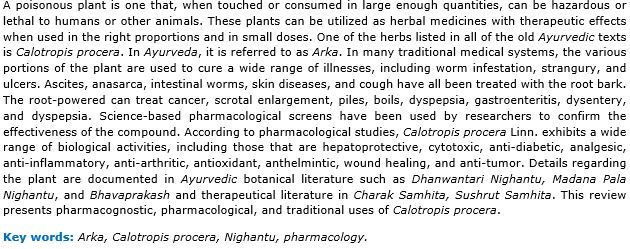Medicinal use of poisonous plant Arka its pharmacological study
DOI:
https://doi.org/10.21760/jaims.8.6.17Keywords:
Arka, Calotropis procera, Nighantu, pharmacology.Abstract
A poisonous plant is one that, when touched or consumed in large enough quantities, can be hazardous or lethal to humans or other animals. These plants can be utilized as herbal medicines with therapeutic effects when used in the right proportions and in small doses. One of the herbs listed in all of the old Ayurvedic texts is Calotropis procera. In Ayurveda, it is referred to as Arka. In many traditional medical systems, the various portions of the plant are used to cure a wide range of illnesses, including worm infestation, strangury, and ulcers. Ascites, anasarca, intestinal worms, skin diseases, and cough have all been treated with the root bark. The root-powered can treat cancer, scrotal enlargement, piles, boils, dyspepsia, gastroenteritis, dysentery, and dyspepsia. Science-based pharmacological screens have been used by researchers to confirm the effectiveness of the compound. According to pharmacological studies, Calotropis procera Linn. exhibits a wide range of biological activities, including those that are hepatoprotective, cytotoxic, anti-diabetic, analgesic, anti-inflammatory, anti-arthritic, antioxidant, anthelmintic, wound healing, and anti-tumor. Details regarding the plant are documented in Ayurvedic botanical literature such as Dhanwantari Nighantu, Madana Pala Nighantu, and Bhavaprakash and therapeutical literature in Charak Samhita, Sushrut Samhita. This review presents pharmacognostic, pharmacological, and traditional uses of Calotropis procera.
Downloads
References
Calotropis R. Br., The wealth of India - a dictionary of Indian raw materials and industrial products (Publications and Information Directorate, CSIR, New Delhi), 3rd Volume, 1992, p.78.
Gupta S M, Plants in Indian temple art (BR Publishing Corp., New Delhi) 1996, p.56.
Kartikar K R and Basu N, Indian Medicinal Plants (Lolit Mohan Basu, Allahabad), 1935, p. 1606.
Verma R, Satsangi G P and Shrivastava J N, Ethno-medicinal profile of different plant parts of Calotropis procera (Ait.) R. Br., Ethnobotanical Leaflets, 2010, 14, 721-742.
Yelne MB, Sharma PC, Dennis TJ. Database on Medicinal Plants used in Ayurveda, Central Council for Research in Ayurveda and Siddha, New-Delhi, 2000, 2(1): 69- 73.
Sharma P.C, Yelne M.B. and Dennis T.J.- Database on Medicinal Plants used in Ayurveda, Vol-3, Published by CCRAS, Reprint-2005,p-69.
Sharma P.C, Yelne M.B. and Dennis T.J.- Database on Medicinal Plants used in Ayurveda, Vol-3, Published by CCRAS, Reprint-2005,p-70.
Ayurvedic uses and Pharmacological activities of Calotropis procera Linn. / Asian Journal of Traditional Medicines, 2011, 6 (2).
Kumar VL, Sangraula H, Dewan S. Preliminary studies on the analgesic activity of latex of Calotropis procera. Journal of Ethnopharmacology, 2000, 73(1-2): 307-311.
Ranab AC, Kamatha. Jagadish V. Preliminary study on antifertility activity of Calotropis procera roots in female rats. Fitoterapia, 2002, 73 (1): 111-115.
Basak K Samar, Bhaumik Arup, Mohanta Ayan, Singhal Prashant. Ocular toxicity by latex of Calotropis procera (Sodom apple). Indian J Ophthalmol, 2009, 57 (3): 232-234.
Jalalpure SS. Anticonvulsant effects of Calotropis procera root in rats. Pharmaceutical biology, 2009, 47 (2): 162-167.
Madigan MT, Martinko JM and Parker J, Brock Biology of Microorganisms. 9th ed. Prentice-Hall, Inc. New Jersey. 783 - 784, (2000).
G. A. Mako, A. H. Memon, U. R. Mughal, A. J. Pirzado and S. A. Bhatti, antibacterial effects of leaves and root extract of Calotropis procera linn. Pak. J. Agri., Agril. Engg., Vet. Sci., 2012, 28 (2): 141-149.
Bhatt, D., Joshi, G. C., & Tiwari, L. M. (2009). Culture, habitat and ethno-medicinal practices by Bhotia Tribe people of Dharchula Region of Pithoragarh District in Kumaun Himalaya, Uttarakhand. Ethnobotanical Leaflets, 2009(8), 975-983.
Anis, M., Sharma, M. P., & Iqbal, M. (2000). Herbal ethnomedicine of the Gwalior forest division in Madhya Pradesh, India. Pharmaceutical Biology, 38(4), 241-253.
Mossa, J. S., Tariq, M., Mohsin, A., Ageel, A. M., Al-Yahya, M. A., Al-Said, M. S., & Rafatullah, S. (1991). Pharmacological studies on aerial parts of Calotropisprocera. The American journal of Chinese medicine, 19(03n04), 223-231.
Azhar, M. F., Siddiqui, M. T., Ishaque, M., & Tanveer, A. (2014). Study of ethnobotany and indigenous use of Calotropis procera (Ait.) in cholistan desert, Punjab, Pakistan. J Agric Res, 52(1), 117-126.
Choedon, T., Mathan, G., Arya, S., Kumar, V. L., & Kumar, V. (2006). Anticancer and cytotoxic properties of the latex of Calotropis procera in a transgenic mouse model of hepatocellular carcinoma.
Rasik AM, Raghubir R, Gupta A, Shukla A, Dubey MP, Srivastava S, Jain HK, Kulshrestha DK. (1999). Healing potential of Calotropis procera on dermal wounds in Guinea pigs. Journal of ethnopharmacology, 68(1-3), 261-6. World Journal of Gastroenterology: WJG, 12(16), 2517.
Misra, M. K., Mohanty, M. K., & Das, P. K. (1993). Studies on the method–ethnobotany of Calotropis gigantea and C. procera. Ancient science of life, 13(1-2), 40.
Basu, A., Sen, T., Ray, R. N., & Chaudhuri, A. N. (1992). Hepatoprotective effects of Calotropis procera root extract on experimental liver damage in animals. Fitoterapia, 63(6), 507-514.
Samvatsar, S., & Diwanji, V. B. (2000). Plant sources for the treatment of jaundice in the tribals of Western Madhya Pradesh of India. Journal of Ethnopharmacology, 73(1-2), 313-316.
Kumar, V. L., & Arya, S. (2006). Medicinal uses and pharmacological properties of Calotropis procera. Recent progress in medicinal plants, 11, 373-388.
Singh, V. P., Sharma, S. K., & Khare, V. S. (1980). Medicinal plants from Ujjain district Madhya Pradesh part II. Indian Drugs Pharm Ind, 1980(5), 7-12.
Singh, A. K., Raghubanshi, A. S., & Singh, J. S. (2002). Medical ethnobotany of the tribals of Sonaghati of Sonbhadra district, Uttar Pradesh, India. Journal of ethnopharmacology, 81(1), 31-41.















